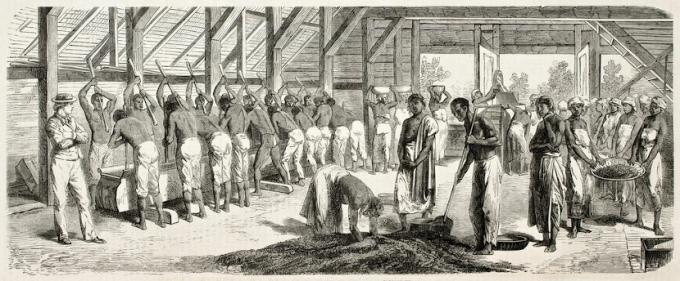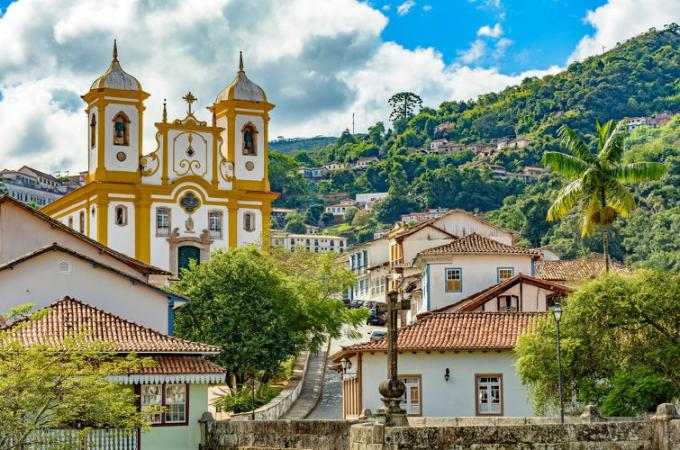Colonization is the process by which human beings occupied new territories around the world. A colonization may aim to housing Or the exploration of resources.
The colonization period in the Modern Age begins at the end of the 14th century, with the economic growth of European and Asian countries. The colonizations from this period are characterized, in general, by the use of violence and domination of native peoples.
THE european colonization, which covered most of the world, had as main motivation the search for goods for marketing and precious metals.
In this period, mercantilism prevailed, an economic model based on trade and the accumulation of gold and silver.
The main colonizing nations of Europe were: Portugal, Spain, England, France and Holland. The period of colonization by these countries begins in the early 15th century and extends into the 19th century.
The colonization of Brazil
The colonization of Brazilian territory by the Portuguese began, in fact, in 1530 and lasted until 1822.
But if the Portuguese arrived in Brazilian territory in 1500, why did colonization begin only in 1530?
Between 1500 and 1530, the expeditions sent by the Portuguese to Brazil were only for reconnaissance of the territory, they stayed for a few months and then returned to Portugal. During this period, only a few factories were built to explore the brazilwood.
Learn more about brazilwood, native tree of the country.
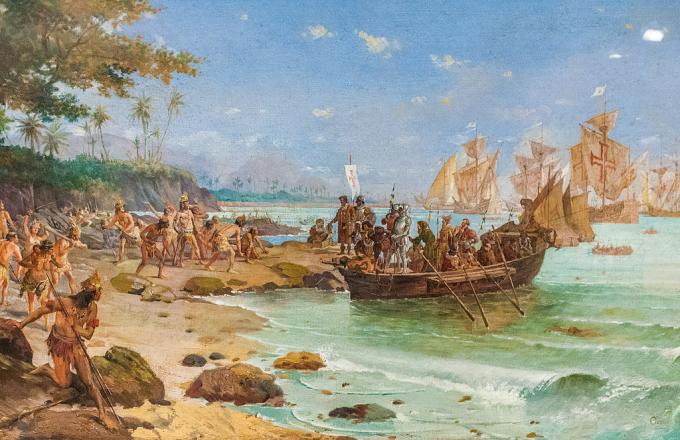 Picture of the disembarkation of Pedro Álvares Cabral in Brazilian territory in 1500. Oil on canvas by Oscar Pereira da Silva (1922).
Picture of the disembarkation of Pedro Álvares Cabral in Brazilian territory in 1500. Oil on canvas by Oscar Pereira da Silva (1922).
THE first colonization expedition was sent on 1531 and was motivated by some concerns on the part of Portugal:
- Fall in profit from trade in the East: by taking Constantinople, the Turks dominated commerce in the East and began to levy a lot of taxes. expensive, making trade unprofitable for Portugal, which forced the country to seek new opportunities commercials.
- Threat from invaders: the American continent had been divided between Portugal and Spain by the Treaty of Tordesillas, but England and France rejected that treaty and threatened to invade the territories of the new world.
- Expansion of the Catholic Church: with the rise of Protestant strands of Christianity in Europe, the Catholic Church weakens and finds itself in the Brazil an opportunity to expand their belief, which happened, especially, with the catechization of the Indians by the Jesuits.
Understand what was the Protestant Reformation.
The Portuguese, upon arriving in Brazil, encountered the indigenous peoples. A large part of these Indians were eliminated in conflicts with the colonizers or by diseases brought by them.
THE Portuguese colonization was marked by the use of the violence and slavery. A large part of the indigenous people who survived were used as slave labor, which would be expanded years later with blacks brought from Africa.
It was agreed to treat as "discovery of Brazil" the arrival of the Portuguese in the region. Using this term, however, would be to disregard the peoples who had already inhabited the territory for centuries.
The first settlements founded by the Portuguese, on the São Paulo coast, were called Vilas de São Vicente and Piratininga. In these villages, the first experiences of planting and cultivating sugar cane were carried out.
Indigenous and black people were used as slave labor in the sugar mills. Called sugar cycle, the period of sugarcane exploration began around 1530 and lasted until the middle of the 18th century.
political organization of the colonial period
The first attempt to organize the Brazilian territory was the Hereditary Captaincies. This system, however, was not successful, so the so-called General Government.
Hereditary Captaincies
Implemented in 1934, the captaincies were extensive swaths of land granted to Portuguese nobles by the King of Portugal Dom João III (1502-1557) - whoever received a captaincy was called grantee.
were created 15 captaincies and ceded to 12 grantees (some received more than a portion of land). These grantees had rights and privileges over the exploration of the territory and owed obligations to the metropolis.
The lack of resources of the captaincies and the attacks by indigenous peoples on these lands, led to the failure of the system. In 1548 another form of political and administrative organization is adopted: the General Government.
General Government
The General Government was a way of centralized organization, commanded by a governor appointed by the King. Among his responsibilities were the economic development of the colony and the protection of the lands.
During this period, new political positions were created, with different responsibilities:
- Chief Ombudsman: justice and laws.
- Major Provider: collection and finance.
- Captain General: defense against attacks from Indians or invaders.
The first governor was Tome de Souza (1549-1553), who built the city of Salvador and made it the capital of Brazil. The next governors of Brazil were Duarte da Costa (1553-1558) and Mem de Sa (1558-1572).
With the death of Mem de Sá, Brazil was divided between the Government of the North, whose capital was Salvador, and the Government of the South, with its capital in Rio de Janeiro. The end of the system of general governments would take place in 1808, with the arrival of the Portuguese royal family in Brazil.
The transfer of the Portuguese court marks the beginning of a process that would culminate in the proclamation of Brazil's independence in 1822 and the end of the colonial period.
Understand how the proclamation of the independence of Brazil.
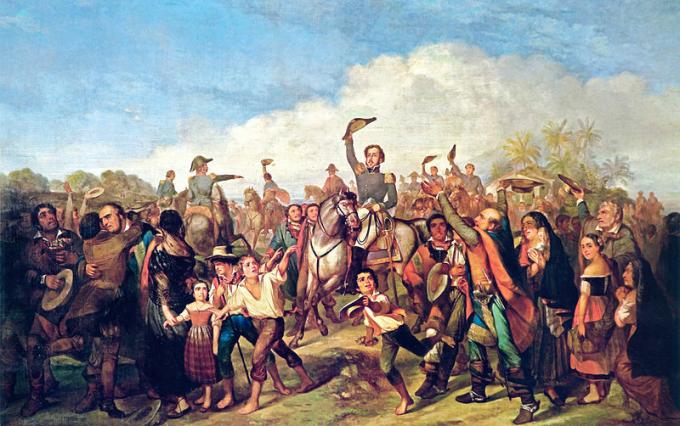 Prince Pedro and crowd after the declaration of independence of Brazil, on September 7, 1822. Oil on canvas by Pedro Américo (1888).
Prince Pedro and crowd after the declaration of independence of Brazil, on September 7, 1822. Oil on canvas by Pedro Américo (1888).
Next, learn about the colonization of other regions in the Americas by the Spanish, English and French.
Spanish colonization
Spanish colonization begins with the arrival of Christopher Columbus on October 12, 1492, on an island in the region of Bahamas. The Caribbean islands were the first Spanish occupations, where most of the natives were decimated by the violence and diseases brought by the colonizers.
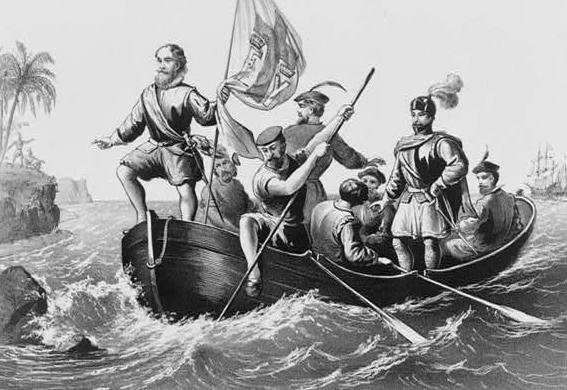 Arrival of Christopher Columbus on the island he renamed San Salvador, Bahamas, in 1492. Author: Currier & Ives (1876).
Arrival of Christopher Columbus on the island he renamed San Salvador, Bahamas, in 1492. Author: Currier & Ives (1876).
Then, Spanish colonization extended to the continental areas of the Americas, dominating a extensive region ranging from what is now California to Patagonia - western part of the Treaty of Tordesillas.
The Spaniards, as well as the Portuguese, aimed to obtain precious metals and the exploration of tropical products to be traded and for that they used slave labor.
A large part of the slave labor in the Spanish colonies was indigenous, which was subjugated by catechizing. African blacks were not used as much by the Spaniards in their territory, with the exception of the Caribbean islands and regions such as Peru, Colombia and Venezuela.
Spanish society was hierarchically divided as follows:
- Chapetones: Spaniards who occupied high administrative functions.
- Criollos: sons of Spaniards who were born in America, in general, worked in large agriculture and commerce.
- Mestizos, Indians and slaves: base of society, performed marginalized functions or were subjected to compulsory labor.
Characteristics of Spanish colonization
Politics
The territory dominated by the Spaniards was divided into three Vice-realms, who were subordinate to the Spanish Crown: Viceroyalty of New Spain, Viceroyalty of India and Viceroyalty of Peru.
From the 18th century onwards, three other Viceroyalties were created: Viceroyalty of New Granada; Viceroyalty of Río de la Plata and Viceroyalty of Peru. Also, four general captaincies: Cuba, Guatemala, Venezuela and Chile.
To administer the extensive Spanish territory, institutions were created for the appointment of Viceroys, for the creation of laws, inspection of activities and collection of taxes and Courts of Justice. In addition, there were the missions, responsible for catechizing the Indians.
Economy
The Spanish colonies had mining as their main activity. The compulsory work of the Indians was carried out in two ways:
- Order: in exchange for work, food and protection, the Indian received evangelization.
- Myth: it was a temporary work regime, usually in mines and under appalling conditions. Indigenous people were drawn for this work and a very small number returned home at the end of the period. Due to the extreme unhealthiness of the work, most ended up dying during the short period of exploration.
English colonization
The English colonized the 13 colonies in North America, which would become the United States. Unlike what happened in the Portuguese and Spanish colonization, the English colonization was done, above all, by the private initiative and not by the State.
England sent "unwanted elements" of the population to North America, such as the unemployed, orphans, criminals, and indebted peasants. Control over these colonies was little, as the metropolis faced internal turmoil, with political and religious disputes.
Society life in the English colonies was marked by a deep segregation between whites, Indians and blacks. It is true that there was segregation and racism in other colonies in the Americas, but in the case of the British, the relationship between these peoples was even more distant.
The union between natives and English was very rare and between whites and blacks was practically non-existent. It is worth adding that during the colonial period, many exterminations of indigenous people were carried out.
See also the meaning of segregation.

British colonies in North America.
Characteristics of English colonization
Politics
The colonization process of North America began in 1606, when the English crown granted the territories of the 13 colonies to two companies: the London company, which dominated the northern territories and the Plymouth Company, which occupied the southern colonies.
These companies had autonomy to explore the territory, but they were subordinate to the English State. Each colony operated under the design of the self-government (self-government) and enjoyed political autonomy.
Economy
The economic activities developed were very different in the northern and southern colonies. O north it had a more temperate climate, used servile labor and produced for the domestic market. Furthermore, these colonies developed the business and the manufacture.
The northern colonies carried out an intense trade with the Spanish colonies in the Caribbean and Africa. During this period, the exchange of enslaved people for rum and tobacco was common.
O south it had a subtropical climate and had as its main economic activity the monoculture for exportation. The working relationship in these colonies was mostly slave.
Find out how the United States Independence.
French colonization
French colonization in the Americas began to be successful in the 17th century, two centuries after colonization by the Iberian countries began. Before that, the country had some unsuccessful attempts to invade the Iberian colonized territories.
The main French colonies in America were New France and Quebec, in current Canada, some islands in the Caribbean, including Haiti and French Guiana in South America.
Characteristics of French colonization
Politics
The French state exercised strong control over the American colonies, but despite this, the country lost its territories over the centuries of colonization.
The first loss was the conquest of New France, which was located in North America, by the British and indigenous people of the region, in 1763. Then they lost other territories in North America itself and also in Asia.
In Haiti, faced a huge revolution of the enslaved population, which resulted in the independence of that country in 1804 - the only one slave revolt to succeed in history.
Understand what a revolution.
 Slave revolution in Haiti.
Slave revolution in Haiti.
Economy
The purpose of colonizing the American territories was the exploitation for the export of tropical products, such as bananas, tobacco, rum, coffee and sugar, with the exception of French Guiana, whose main activity was fishing and gold mining.
In the conquered territories in North America, which are now part of Canada, the main product explored by the French was the animal skins, mainly beavers and foxes.
The North American colonies used free labor, while in the Caribbean islands, there was extensive use of slave labor.
See also the meaning of mercantilism.

